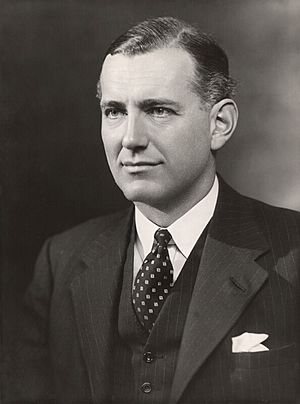Harold Balfour, 1st Baron Balfour of Inchrye facts for kids
Quick facts for kids
The Lord Balfour of Inchrye
|
|
|---|---|
 |
|
| Minister Resident in West Africa | |
| In office 21 November 1944 – 26 July 1945 |
|
| Prime Minister | Winston Churchill |
| Preceded by | The Viscount Swinton |
| Succeeded by | Office abolished |
| Under-Secretary of State for Air | |
| In office 16 May 1938 – 21 November 1944 Serving with The Lord Sherwood (1941–1944)
|
|
| Prime Minister | Winston Churchill |
| Preceded by | Anthony Muirhead |
| Succeeded by | The Lord Sherwood and Rupert Brabner |
| Member of Parliament for Isle of Thanet |
|
| In office 30 May 1929 – 15 June 1945 |
|
| Preceded by | Esmond Harmsworth |
| Succeeded by | Edward Carson |
| Personal details | |
| Born | 1 November 1897 Camberley, Surrey, England |
| Died | 21 September 1988 (aged 90) Shefford, Berkshire, England |
| Political party | Conservative |
| Military service | |
| Allegiance | United Kingdom |
| Branch/service | British Army (1914–1918) Royal Air Force (1918–1923) |
| Years of service | 1914–1923 |
| Rank | Major (British Army) Flying Officer (Royal Air Force) |
| Unit | 60th Rifles (1914) No. 60 Squadron RFC (1915–1917) No. 43 Squadron RFC (1917) No. 40 Squadron RFC (1917–1918) No. 43 Squadron RAF (1918) |
| Battles/wars | First World War |
| Awards | Military Cross & Bar |
Harold Harington Balfour, 1st Baron Balfour of Inchrye (born November 1, 1897 – died September 21, 1988), was a British politician. He was a member of the Conservative Party. He was also a brave pilot, known as a "flying ace," during the First World War. In 1944, while serving as the Under-Secretary of State for Air, he played a key role in setting up London Heathrow Airport.
Contents
Early Life and Education
Harold Balfour was born in Camberley, Surrey, England, on November 1, 1897. His father was Colonel Nigel Harington Balfour. Harold went to Chilverton Elms School in Dover, Kent.
He also attended the Royal Naval College, Osborne, on the Isle of Wight. After two years, he left the college. He then finished his education at Blundells School in Devon.
Aviator and World War I Flying Ace
In 1914, Harold Balfour joined the 60th Rifles and served in France for three months. He then moved to the Royal Flying Corps, which was the UK's air force at the time. After his training, he joined No. 60 Squadron.
In 1917, while flying with No. 43 Squadron, he shot down two enemy aircraft. He was flying a Sopwith 1½ Strutter plane. After being injured in a plane crash, he moved to a training school. He later returned to No. 43 Squadron.
Now flying a Sopwith Camel, he achieved 7 more victories against enemy planes. This earned him a promotion to major. Balfour then took command of a training school until 1919. He later worked as a private secretary and aide-de-camp for Air Vice Marshal John Salmond. He also worked for Sir Samuel Hoare, who was the Secretary of State for Air. In 1923, he left the Royal Air Force to work in journalism and business.
Political Career
Harold Balfour first tried to become a politician in 1924 but was not successful. In 1929, he was elected as a Member of Parliament (MP) for Isle of Thanet. An MP is a person elected to represent a group of people in the UK Parliament.
He worked in the Air Ministry starting in 1938. From 1944 to 1945, he served as the Minister Resident in West Africa. This role meant he was a special representative for the UK in that region. In 1941, he became a member of the Privy Council of the United Kingdom.
He left the House of Commons, which is part of the UK Parliament, in 1945. After this, he was given the special title of Baron Balfour of Inchrye. Harold Balfour passed away on September 21, 1988, at the age of 90.
Family Life
Harold Balfour was married twice. His first marriage was in 1921 to Diana B. Harvey, and they had one son. His second marriage was in 1946 to Mary Ainslie Profumo. They had a daughter together.
His son, Ian Balfour (1924–2013), became the 2nd Baron Balfour of Inchrye after his father's death. Ian was known as a historian who studied diamonds.
Awards and Recognitions
Harold Balfour received several important awards for his bravery and service.
- Military Cross: On May 26, 1917, he was given the Military Cross. This award was for his "conspicuous gallantry and devotion to duty." He completed many important scouting missions in difficult conditions. He also shot down two enemy aircraft.
- Bar to the Military Cross: On April 22, 1918, he received a bar to his Military Cross. This meant he earned the award again. He was recognized for destroying one enemy machine and forcing two others down in one month. He also flew at a very low height in bad weather to scout. During this mission, he bombed two guns, attacked troops, and fired at enemy airfields. He was seen as a leader with great courage and skill.
- Baron Title: On July 5, 1945, Harold Balfour was given the title of 1st Baron Balfour of Inchrye. This made him a member of the peerage.


